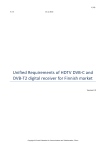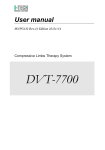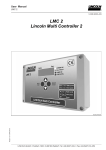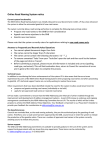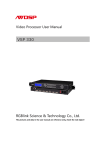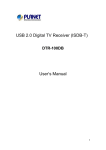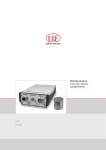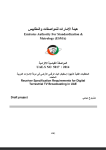Download (A) Migration Process
Transcript
Frequently Asked Questions (FAQs) on digital migration
Collated categories; (A) Migration Process, (B) Migration Technology, (C) Digital
Benefits, (D) Set-Top Boxes, (E) Infrastructure Rollout, (F) Signal Reception, and
(G) Consumers
(A)
Migration Process
1. Why must Kenya migrate?
The Regional Radio Conference (RRC) meeting of 2006 set 17th June 2015 as the deadline for all
countries in the planning area (comprising of Africa, Europe, Russia and Iran) to migrate to
digital terrestrial broadcasting technologies. It is, therefore, mandatory for all countries in the
said planning areato migrate to digital terrestrial television broadcasting technology.
2. What is the timetable for the migration in Kenya?
The migration is expected to take a minimum of three (3) years. During the migration period,
viewers are able to receive the current analogue TV broadcasts. However, , viewers without
digital set-top boxes or integrated digital TVs (idTV) will be unable to receive any new digital
channels or services broadcast on the digital platform. The process of switching off the analogue
signal in Kenya is expected to be completed by end of 2012. After that, viewers will need to have
DTT set-top boxes or idTVs to receive free-to-air terrestrial television services. Kenya
Broadcasting Corporation (KBC TV) is conducting a trial to test the new DTT services and
technology. This trial begun in October 2009.
3. Must I wait until 2012 to switch to digital TV?
No. You do not need to wait until 2012 to switch to digital TV. If you are in an area that is
currently covered by the digital signal (like Nairobi and its environs), all you need is to purchase
a DVB-T2 MPEG 4 set top box which you will connect to your existing analogue TV. This set
top box will therefore enable you to receive digital broadcast on your existing analogue TV using
your existing UHF aerial. 2012 has been set as the analogue switchover date. This means that
broadcasters will shut down their analogue TV transmitters and only digital TV signal will be
available thereafter. In that case, if by then you will not have acquired a set top box or an
integrated digital TV, you will then not be able to receive digital TV service (analogue TV will
also not be available).
1
4. Are we on track to meeting the 2012 deadline?
Yes, we are on track to meeting the 2012 deadline. The government will keep the public updated
including information on any changes that may arise with respect to the deadline.
5. But with the change in technology to DVB-T2 set top boxes are we still on target to
fully migrate the country to Digital broadcasting?
Yes we believe we will meet the national deadline of 2012 long before the global deadline of 2015. In the
event circumstances necessitate extension of the national analogue switchover deadline, the public shall
be adequately informed.
6. Will Kenya implement a coupon system as they did in the U.S to subsidize the cost?
We are aware of the coupon system that was used in USA. However, for our case in Kenya, the
coupon system will not be used because of the budgetary challenges the government is currently
facing. Instead, the government is studying other proposals, which if implemented, will result in
affordable prices of set top boxes.
7. With the new technology, will I be required to pay monthly subscriptions?
The digital technology supports both free to air and subscription/pay TV. You will therefore not be
required to pay any monthly subscriptions unless you choose to subscribe to the pay-tv option.
8. Are the current broadcasters (local) broadcasting on the platform?
The existing TV broadcasters signal was broadcast on the digital platform in Nairobi and environs from
the December 2009 until December 2010 when they pulled out their programmes from the platform in
protest against the KBC’s accommodation of a new broadcaster on the platform. The matter is now
pending in the High court..
(B)
Migration Technology
1. What is migration from Analogue to Digital Broadcasting?
2
Migration from analogue to digital broadcasting refers the process in which the analogue TV
broadcasting services are converted to and replaced by digital television broadcasting. At the end
of migration usually carried over a specified period , the analogue broadcasting services are
eventually broadcast in digital format while the analogue transmitters are switched off.
2. What is Digital Terrestrial Television (DTT)?
Digital broadcasting is the conversion of sound, video and text into digital data and
subsequent the transmission of the digitized data over television channels or assigned radio
frequency bands for reception by the public. Sound, video and text are processed
electronically and converted into digital format. This format is then transmitted and
reconverted by appropriate receivers or set-top boxes into sound, text and video for display
on TV set. Terrestrial denotes television broadcast using equipment situated on the ground
rather than by satellite
3. What is the difference between analogue TV and Digital TV?
Analogue and digital television differ in the way the information is carried from the source to the
receiver. In simple terms, in analogue broadcasting the signal is in the form of a continuous
wave, whereas digital is in the form of discrete bits of information.
In digital, the signal is encoded and can be compressed to allow for more channels to be
broadcast. For instance eight (8) new standard definition TV (SDTV) programmes can be
provided in the same frequency channel as one analogue TV channel.
4. Will I need to buy a new TV to receive DTT?
No, you do not need to buy a new TV if you already have an analogue TV. However, you will
need to buy a digital set top box that complies with DVB-T2 transmission technology and
MPEG 4 compression format. Current TV sets should be able to receive DTT using the set-top
boxes. Your TV must have audio and video inputs (A/V), or alternatively RF input so that your
set-to box can be plugged into your TV. With this, you should be able to use your current TV set.
You do not need a High Definition (HD) TV, LCD TV or Plasma TV to receive DTT.
In countries which began migrating to digital broadcasting years back such as in Europe,
integrated digital television receivers or idTVs (TVs with inbuilt digital tuners) are readily
available in their markets. However, these idTVs may not be available in Kenya at the moment
but will gradually become available locally once digital terrestrial broadcasting takes root in
3
Kenya. It is also important to note that generally, the price of idTV tend to be higher than that of
a STB.
5. What equipment will be required to receive digital television?
You either need a integrated Digital Television (which has an inbuilt digital tuner) together with
a UHF aerial or an analogue TV set together with a digital set top box and a UHF aerial
6. What is an integrated digital television receiver (idTV)?
This is a television set which contains all the components necessary to receive and display digital
transmissions. Integrated digital television receivers have inbuilt digital TV tuners ( for our case
DVB-T2) and hence does not require digital set top box. Consumers should be careful not to be
duped by vendors in believing that wide screen TVs are idTVs. You must confirm that it indeed
has an inbuilt digital tuner
7. Will consumers need to buy a new antenna, satellite dish or cabling?
To receive DTT, one needs a UHF antenna. Satellite dishes are not required. In the majority of
cases, existing UHF antennas currently used to receive analogue TV will be adequate to receive
digital television transmissions so long as they are maintained in good condition and are properly
installed,. They work better if installed on the rooftop where there is limited obstruction. The
aerial should be oriented in the general direction of the digital TV transmitter tower.
8. Are digital TV sets in the market and where I can buy one?
Integrated digital TVs may not be readily available in the local market at the moment but vendors may
start stocking them if there is a business case for them. They are however are available in other parts of
the world such as in Europe, but tend to be more expensive as compared to analogue TVs. If you already
have an existing analogue TV, you do not need to buy another new TV specifically for reception of the
new digital signal. All you need is a set-top box. The CCK will endeavour to make information available
on its website regarding outlets which stock such products in Kenya once such information becomes
available.
9. What is Standard Definition television (SDTV)?
Standard Definition television (SDTV) is a television whose display has a vertical and horizontal
resolution of 640 x 480(NTSC) or 768 × 576(PAL)... The aspect ratio of SDTV is either 4:3 or
16:9.
10. What is a High Definition television (HDTV)?
High Definition Television (HDTV) is a television whose display resolution is higher than that of
standard definition TV, offering high picture resolution and enhanced sound quality. There are 2
4
high-definition resolutions in use, 1280 x 720(720p) and 1920 x 1080(1080i and 1080p). A “Full
HD”(1080p) display refers to a display with native resolution of 1920 x 1080.
11. How does the quality of SDTV compare to HDTV?
12. HDTV provides a sharper and more detailed picture/video than SDTV because in HDTV,
more lines and pixels are used to scan the picture. These make the picture look sharper and
more detailed to a viewer. However, perceptions of 'quality', as seen by the viewer, may be
affected by other factors besides picture sharpness.
13. What is Multichannelling?
Because a digital signal can carry much more data than an analogue signal, more than one
channel of television programs can be broadcast at the same time. This is known as
multichannelling.
14. What are program enhancements?
Viewers of digital television will have a wide choice of 'enhancements' to regular programming.
Enhancements are separate channels of video, data or audio, which are related to the program on
the primary channel. Sporting events will offer the choice of different camera angles, action
replays, player profiles or other information. Across a range of programming, digital viewers will
have a choice to select more information related to the regular program - product information,
recipes, news background and much more. In addition, if a sports event overlaps with news,
digital viewers may be offered the opportunity to watch the regularly scheduled news bulletin or
the completion of the event on a separate channel.
15. What is Datacasting?
Because a digital signal can carry much more data than an analogue signal, the extra capacity can
be used by broadcast service providers to provide other information services to viewers, in
addition to regular program channels. This is known as datacasting.
16. Can I use my DSTV dish to receive digital transmission?
No. DSTV dish can only receive satellite transmission. You need a UHF aerial to receive the
digital terrestrial TV transmission.
17. Will my old multichoice analogue decoder work with this technology? Will my existing
boosted aerial still work?
Your old multichoice decoder will not work with this new technology because it is a satellite
decoder for satellite reception.. What you need is a DVB T2 MPEG4 set top box to receive the
new digital TV signal. If you already have a UHF TV antenna, all you need is to point it towards
the transmitting site (i.e Limuru, in the case of Nairobi).
5
18. As we migrate to digital TV, is there new technology to access programmes via a
password/code to restrict or block viewing nudity and indecency in my house using the
TV remote control?
The technology being introduced has the capability for one to maneuver around the programs
you want to watch by using an interface called conditional access. However, conditional access
will not apply on free-to-air channels.. However, some of the features of set top boxes include
parental control in which case certin channels can be programmed to be accessible only by
inputting a password using the remote control.
Regarding the issue of inappropriate content, the CCK will issue aprogramming code for
broadcasters which upon gazetement, shall be the basis of content regulation. Once in force, free
to air broadcasters will have to adhere to its provisions and action will be taken against those
flouting the code .
19. How many TV channels can I receive with my set-top box?
Your set top box should receive all the free to air and subscription channels being transmitted in
your locality, either byKBC/SIGNET or by other broadcast signal distributors who may
commence services in the area.. However, access to subscription channels shall be limited to
consumers who have subscribed to the pay TV service..
20. Should someone using a computer with TV card buy a set top box? Please explain.
If you are using a TV card to receive programmes from the existing TV stations, it means that
the TV card has an analogue TV tuner. In this regard, you will not be able to receive the digital
signal on your computer. What you need then is a DVB T2 MPEG4 TV tuner card (together with
the relevant software) otherwise if you have to continue using your current analogue TV card,
then you will need to have a set top box as well (to convert the digital signal into analogue for
your card to understand) in order to receive the digital signal on your computer.
21. Can I view both DSTV programs and Digital signals on the same TV set?
Yes, but not at the same time. To view DSTV programmes on your TV set, you must first have a
valid subscription, a DSTV satellite dish and a DSTV decoder duly installed. In the case of DTT,
you should have a DVB-T2 MPEG-4 digital set top box and a UHF TV aerial.
22. What is DVB-T2
6
DVBT-2 is an abbreviation for Digital Video Broadcasting – Second Generation Terrestrial. It is the
enhancement of the television standard DVB-T, used for the digital TV broadcast transmission. This
system transmits compressed digital audio, video, and other data .With higher bit rate offered, compared
to its predecessor DVB-T, it is a suitable system for carrying more SDTV, HDTV, mobile TV and other
multimedia signals on the terrestrial TV channel. It is currently deployed in UK (Free view HD, four
channels), Italy (Europe 7 HD, twelve channels) and since November 1, 2010 in Sweden (five channels).
(C)
Digital Benefits
What are the advantages of Digital Broadcasting?
Digital television is a far more efficient and flexible transmission system than the current
analogue system. It allows broadcasters to offer viewers a range of new and different services.
Digital television features can include:
Much improved reception capability, including the elimination of ghosting and other
transmission errors.
A 16 x 9 aspect ratio, or screen shape. This is also known as widescreen. It is similar
to the aspect ratio that is widely used in the cinema.
Standard Definition Television (SDTV).
High Definition Television (HDTV).
High quality audio.
Electronic Program Guides (EPGs). A basic EPG can be used by viewers to navigate
between channels, identify the currently screening programme and the next
programmme ('now and next') on each channel. More sophisticated EPGs can be used
to set reminders for program viewing, provide a short synopsis of the content of
programs, identify programming in advance for several days, search for programs by
genre, and provide access to some enhancements.
Multichannel programs.
Radio programs.
Program enhancements on separate channels to the primary program, e.g., additional
camera angles on a sports match, statistics about a player, or additional information
about a segment in a lifestyle or magazine program.
Broadcasters will be allowed to broadcast more than one channel when certain
events, such as sporting matches, extend beyond time due to circumstances beyond
the broadcasters' control, and overlap a regularly scheduled news program. This will
allow viewers the option of continuing to watch the end of the event or the news
bulletin.
Over time, interactive television services and data casting services, including selected
Internet services, home shopping, computer games, etc will be provided by
broadcasters and data casters.
7
What are the advantages of using DVB-T2 over DVB-T?
With DVB-T2 , it is possible to have 50% more programme channels in one TV frequency as
compared to DVB-T. It also offers the flexibility to simultaneously accommodate on the same
digital platform high definition TV, standard definition TV, mobile TV and digital audio.
(D)
Set-Top Boxes
1. What is a set-top-box?
It’s a receiver that decodes or converts the digital signal to analogue to enable the channels to be
displayed on your analogue TV set. This set-top box is plugged into your TV set. The DTT settop box (also referred to as a decoder or converter box) is however not the same as the existing
satellite or terrestrial-based pay TV service decoders. Analogue television sets cannot display
digital transmissions on their screens without being connected to such a set-top box converter.
2. What does a set top box do?
. A set top box receives the digital TV signal captured over the air by the aerial and converts the
digital signal into a format that can be understood and displayed by an analogue TV The features
of a set top box are usually dependant on its specifications
3. Why do I need a set-top box?
It is the device that decodes the digital signal received via UHF aerial or antenna and supplies the
TV set with the video signal. Without the set-top box you will be unable to display the digital TV
services on your analogue TV set.
4. What are the specifications for the right set-top box?
The platform for analogue to digital TV migration that has been adopted in Kenya is DVB-T2
MPEG-4. Details of minimum specifications for a compliant set top box are available on the
CCK website www.cck.go.ke/about/digital_kenya/index.html.
5. Do I need an outdoor aerial for my set-top box to receive digital signals?
Yes. You need a UHF aerial facing the direction of the digital transmitter tower(Limuru for those
in Nairobi and its environs).
6.
If I have two TV sets, can I connect my set-top box so that each receives its
own digital TV Channel?
8
No. You cannot use one set-top box to receive more than one program at a time. Each TV set
requires a set top box. However, there could be some products that could be available in the
market that enables the splitting the signal which can then facilitate sharing.
7. Can my set-top box receive DSTV programmes?
No. The set-top box only receives TV programmes transmitted from the digital terrestrial
transmitters. DSTV programmes are received from satellite hence you need a DSTV decoder and
satellite dish..
8. How do I connect my set-top box to the TV set if my TV does not have AV
terminals?
Before buying a set-top box you need to know what type of inputs your TV supports so as to
know the type of set-top box to buy. Set top boxes also have RF modulator output port which
then can be used to connect to the TV RF in.
9. Do I need to pay monthly subscriptions with my set-top box to watch
programmes?
No, you don't have to pay monthly subscriptions to watch Free-to-Air programmes. Subscription
is necessary when accessing pay channels.
10. Are there set-top box in the market, and if so where?
Yes, there are DVB-T set-top-boxes in the local market particularly some supermarkets and
electronics shops in Nairobi. However, note that DVB-T standard was used for the pilot phase
will only be usable in Nairobi till 2012. Going forward, Kenya has adopted the enhance DVB-T2
standard. Any new transmitters being rolled out will be on DVB -T2 technology hence you need
to purchase a DVB-T2, MPEG 4 STB to avoid interruption after 2012.
11. I recently purchased an LCD Sony Bravia TV having the idea it was a digital
one. However CCK said that digital TVs are not yet in Kenya. So from which
outlet can I purchase the decoder (converter), at what price including
installation?
Most TV sets currently in the local market are analogue TV but can be digital-enabled by a set
top box. The said Sony Bravia has analogue TV tuner and not digital tuner. Note that the digital
signal is only available for now in Nairobi and environs. Other parts of the country will be
covered gradually in subsequent phases of digital rollout. Prices are largely dictated by market
forces and are not fixed by the CCK. Some outlets currently stock the previously type-approved
DVB-T set-top boxes at prices ranging between Sh5,000 and Sh10,000 depending on the type of
STB. You do not need to pay someone to do an installation. Setting up a set-top box is a simple
process (similar to DVD player). Just follow the instructions given in the user manual and enjoy
digital services. When purchasing a set top box or idTV, it is your responsibility to confirm it is
DVB-T2 MPEG4 compliant.
9
12. Can my plasma digital screen receive the digital signal without the set-top
box?
No, unless the plasma is an integrated TV receiver (has an inbuilt digital decoder.) that is DVBT2
13. Is there limitation on the age of the analogue TV that can be used with the
set-top box?
The age of the analogue TV is not a factor. So long as your TV has AV input , you should use it
with a set top box. You can also use the RF output of the STB to connect to the RF IN of the TV.
More importantly, follow your user manual instructions which are simple to implement.
14. If I have an integrated TV set or a set-top box from say America or Japan
will it work with the platform?
No. It will not work. The Kenyan platform is a DVB-T2 system. The ITV from America is
ATSC system while the Japanese one is ISDBT system. We don’t have multisystem Digital TVs
or STBs yet.
15. Are DVB-T2 set-top-boxes available in the market and where can I find
them?
There may be DVBT-2 set-top-boxes that may have been imported since the government upgraded the
technology but CCK has not yet type-approved any of the imports for sale in the market. We hope that
entrepreneurs will take up the opportunity and import them and seek type-approval from CCK before
selling them to consumers.
16. What do I do with my current set-top box that is on DVB-T?
Your current DVB-T set-top-box will only be usable in Nairobi and environs till 2012 since the existing
DVB-T digital platform used in pilot phase shall be maintained during the simulcast period. After 2012,
the DVB-T platform will be upgraded to DVB-T2 hence you will need to purchase a DVB-T2 MPEG 4
set top box to continue receiving digital TV programmes.
17. Is there a compensation plan for the traders or consumers who have already
purchased the DVBT set-top-boxes?
There’s no compensation plan as the government has given adequate notice. The change to DVB-T2 is a
technological advancement hence compensation not applicable
What is the price of a DVB-T2 set-top box?
10
The price should range between Ksh5,000 and Ksh10,000 depending on the set-top-box brand. The price
will be determined by market forces. It is important to ask the vendor for his authorization and type
approval certificate issued by CCK.
18. Which is the preferred brand of set-top-box?
The market forces will determine the best brand. Also your preference on the services you enjoy will
determine your set-top-box choice. The CCK only specifies the minimum specifications for the DVB-T2
set top box which can be downloaded from the CCK website; www.cck.go.ke.
(E) Infrastructure Roll-out
1. Evaluating what has taken place in the last couple of months – since
the launch of the platform - what are the milestones made so far?
Pilot phase
In December 2009, the pilot phase of the digital television broadcasting was launched in Nairobi.
The phase was meant to be a test case during which important lessons are learnt and necessary
adjustments made in all aspects in readiness for the real migration. This was also meant to give
an opportunity for Kenyans to sample the features of digital terrestrial TV broadcasting before
full migration kicks off. So far, the following milestones have been achieved:
Role of DTC/Secretariat
The Digital Transition Committee (DTC) continues to meet and deliberate issues related
to the next phase of rollout. A DTC Secretariat is now fully functional. In addition to
providing the DTC with technical and logistical support, it also responds to enquiries
from Kenyans on various aspects of the migration process and can be reached though its
email address; [email protected].
Broadcasters on the platform
A number of broadcasters have been hooked up on the digital platform for purposes of
test transmission of the digital signal and the functioning of the digital infrastructure
installed in Nairobi. They pulled out of the platform in December 2010 in over an issue
which they have taken to court. The case is still ongoing and once resolved, the
broadcasters are expected to provide their broadcast signals to the digital platform again.
Migration funding
Digital migration in Kenya was initially planned to be fully funded by government. This
was evidenced by the funding provided for the pilot phase as well as the operations costs
of running the existing digital platform. However, the government has continued to
encounter challenges to fund the migration process due to funds re-allocation especially
when the country faces emergencies such as drought, etc that require priority funding. .
In order to mitigate the funding challenges, the government is exploring other options
11
that would fast track the infrastructure rollout in view of uncertainty of anticipated
funding from government. These include PPP arrangement for private sector to invest in
SIGNET and the revision of the Policy to allow for licensing of other broadcast signal
distributors. These measures are expected to bring the digital migration back on track.
Regulations gazetted
The Kenya Communications (Broadcasting) Regulations, 2009 have been gazetted. The
CCK is finalizing a framework for regulation and licensing of broadcasting services.
Once the framework is finalized, the Commission will implement the same paving way
for licensing of more broadcasters to be accommodated on the digital platform.
Standardization of STBs
With regard to standardization of set top boxes, CCK is collaborating with KEBs and the
process of gazetting national standard by KEBs is at an advanced stage. In addition, the
CCK continues to license vendors of set top boxes and also type approves/accepts set
top boxes which are compliant with the issued specifications.
Regional harmonization of migration
The CCK continues to play an active role at the East Africa regional level where the 5
EAC countries have agreed to harmonise issues related to migration to digital
broadcasting. The common meetings continue to address salient issues identified for
harmonization in this regard.
Zero-rating STBs and other equipment
Follow-ups are being made to the Finance Ministry by the DTC and the Ministry of
Information & Communications with respect to removal of taxes on set top boxes and
digital broadcasting equipment beginning next financial year. This will ensure set top
boxes are readily available at very low prices that will be affordable by ordinary
Kenyans.
Licensing other digital signal distributors
The government has reviewed its policy that now provides for the licensing of other
broadcast signal distributors to compete with KBC’s subsidiary SIGNET. Tenders for
Expression of Interest for signal distributors have already been evaluated paving way for
next stage of tendering
The CCK is expected to finalise the licensing process before the end of 2011.
Adopting the DVB-T2 standard
The country has adopted the DVBT-2 standard that has immense advantages over the
DVB-T standard. The standard will be used in the countrywide roll-out.
2. If I stay in say Mombasa or Kisumu can I receive digital signals?
When will other areas outside Nairobi be covered?
12
The digital signal is currently only covering Nairobi and its environs in this first phase. Digital
broadcasting infrastructure rollout shall be done in phases. Other main cities including Mombasa
and Kisumu shall be covered in the next phase.. The implementation of digital broadcasting
infrastructure countrywide will require a lot of capital investment. Information regarding specific
timeframes of implementation will be made available once the implementation plan is
concluded.
(F)Signal Reception
I have connected my set-top box but I can only receive sound and a picture that
freezes then disappears what could be the problem?
The level of the digital signal you are receiving is very low. You may need to improve your
aerial system by using a booster or increasing the height of the aerial and ensuring it is pointing
in the correct direction where the digital signal is being transmitted from.
I have a DTV card (PC) and I am able to receive 16 channels.
They are however not displaying the right channel. Are all the
channels on board (EATN, CNBC, STV, Classic and Kiss)?
Yes, it is true that the digital TV signal that you are receiving using your PC card is not correctly
displaying the channel names harmonized with the content displayed. The naming of the
channels is correct as those positions are reserved for the said broadcasters. However, due to the
fact that at the time of launch of the digital signal, some of the existing TV stations had not
finalized the linking of their studio signals to the multiplexing facility at KBC, the channels have
been filled with content of other stations that had managed to link to this facility. For instance
NTV content appears on several channels not labeled NTV. As soon as all the media houses
avail their signal to the multiplex platform, the content shall be aligned accordingly; the stop gap
measure has been taken to avoid having blank channels which may be annoying to some viewers.
I have connected my set-top box to the TV set as
recommended but there is no signal at all.
We provide some tips below that can assist in trouble shooting. However, it is recommended that
you consult the user manual of the set top box,
Ensure there is communication between your set-top box and the TV set by selecting the
AV mode.
Ensure that your outdoor aerial is well connected and preferably installed on the rooftop
and pointing in the direction of the digital transmission tower.
Ensure both the TV set and the set-top box are powered.
Try changing the position of the aerial especially if there is obstruction between the aerial
and the digital transmission site.
How Can I know if my current TV is analogue or digital?
13
What differentiates a TV receiver is the type of tuner it has. Almost all TV receivers in
the country have analogue tuners (PAL B or G). A digital TV has a digital tuner and
cannot receive TV programmes broadcast in analogue format. If you are currently
receiving the local free to air TV channels on your current TV without using a Set Top
Box, then it means your TV tuner is analogue because the local TV stations are currently
transmitting in analogue format. You can also consult your TV user manual and if you
need further assistance to determine the type of tuner your TV has, consult the secretariat.
Do I still need to use my TV aerial when I acquire a set top
box?
Yes, you still need an aerial in order to be able to capture the digital TV signal in the air.
The set top box is not a replacement for the TV aerial. The cable from the aerial will need
to be plucked into the set top box for it to receive the DTT signal. Since DTT will be
rolled out in the UHF band, viewers who have been using VHF TV aerial will need to
acquire a UHF aerial and point it in the direction of the DTT transmitter in order to obtain
a clear signal. Information shall be provided on continual basis regarding which direction
viewers in particular areas need to point their aerials in order to receive good signal, as
the service becomes available in those areas
(G)
Consumers
1. What would you say is the level of awareness among ordinary folks and are
there plans for campaigns to further entrench the idea among all Kenyans?
The Commission has continued to run adverts under the 'Digital Kenya' banner in the print media
educating the public regarding migration to digital broadcasting since mid last year. This is
expected to continue until the country is fully migrated. The Commission will continue to set a
budget for consumer education and awareness campaigns as the digital broadcasting services are
rolled out.
The Commission has provided contacts to which enquiries regarding digital broadcasting are
forwarded to. The Commission receives many enquiries by telephone, email, or face to face
visits and addresses all the enquiries promptly (our response to your question demonstrates this
commitment to educate the media and ordinary Kenyans regarding migration to digital
broadcasting).
14
A secretariat, housed at CCK, is operational to specifically deal with consumer queries regarding
digital broadcasting and can be reached through its website; [email protected].
A major consumer education (through print, electronic media, road shows, etc) is to be launched
to run in tandem with rollout of the digital platform. The necessary budgets have been secured
and campaigns will commence once other related logistics are finalized. You will agree with us
that increased campaigns can only be effective if they are synchronized with the pace of digital
network rollout. Again this will be a CCK annual commitment to ensure that all parts of the
country and Kenyans are adequately educated.
15

















